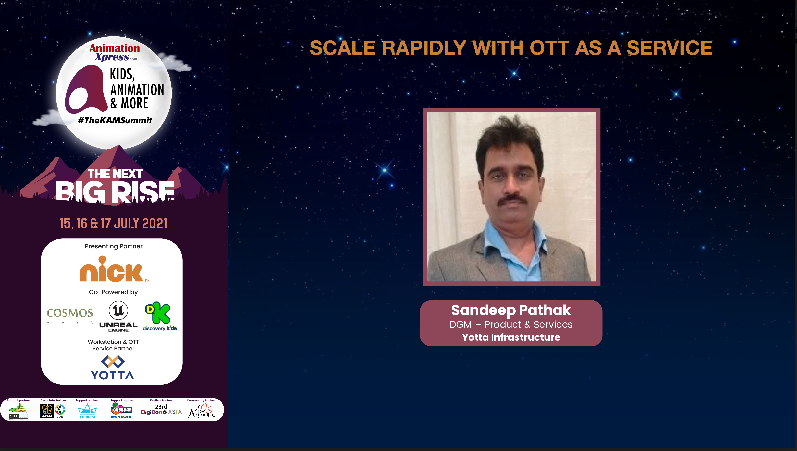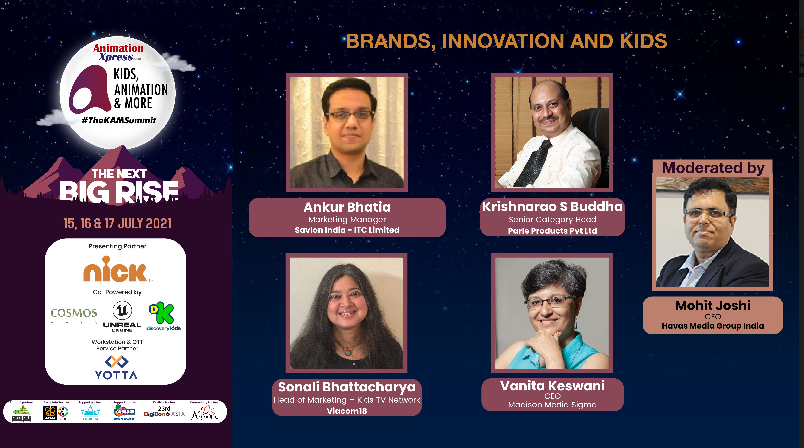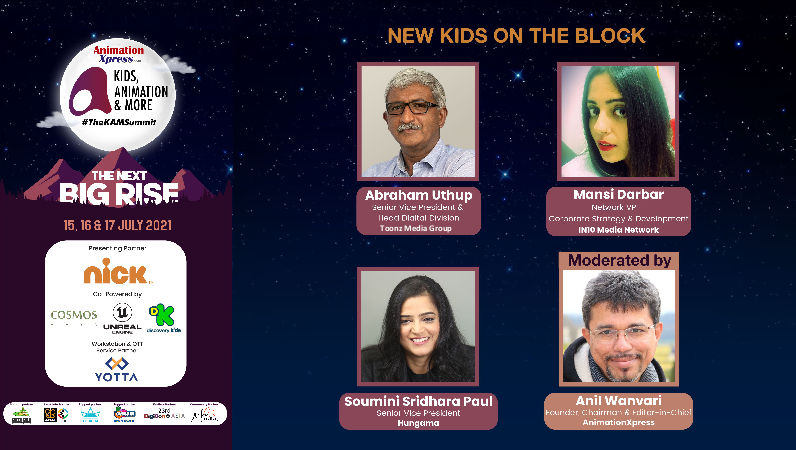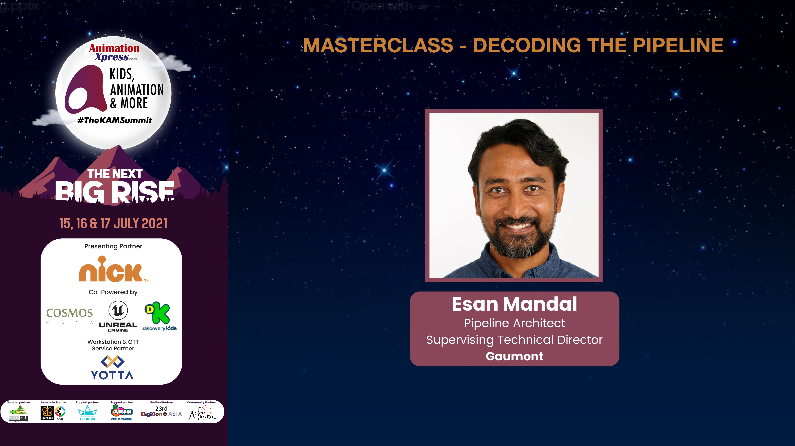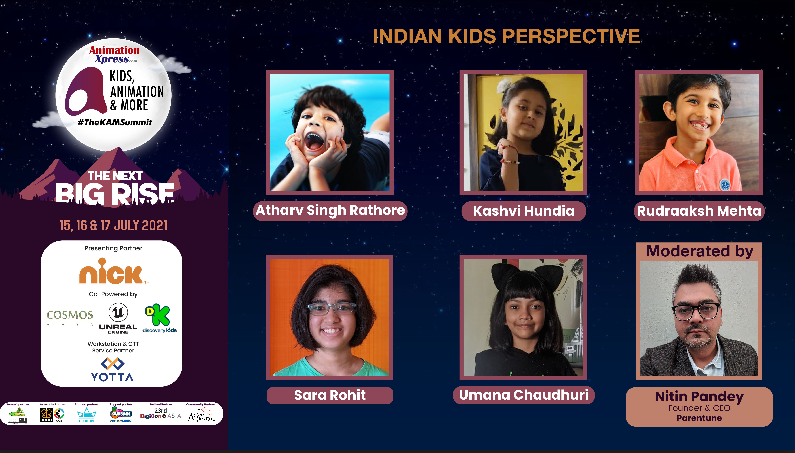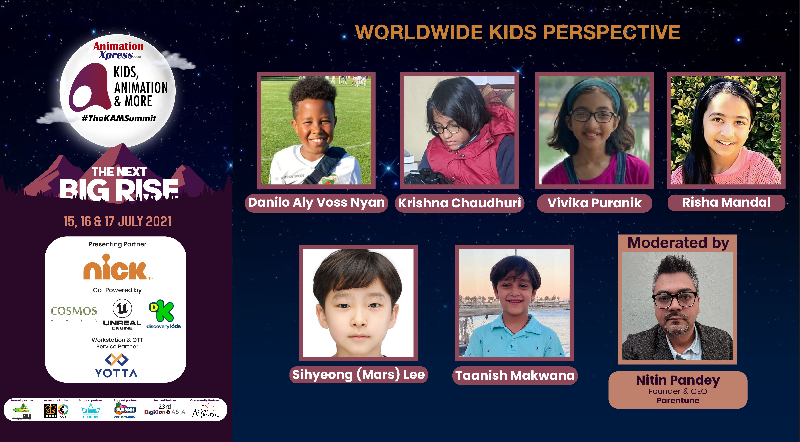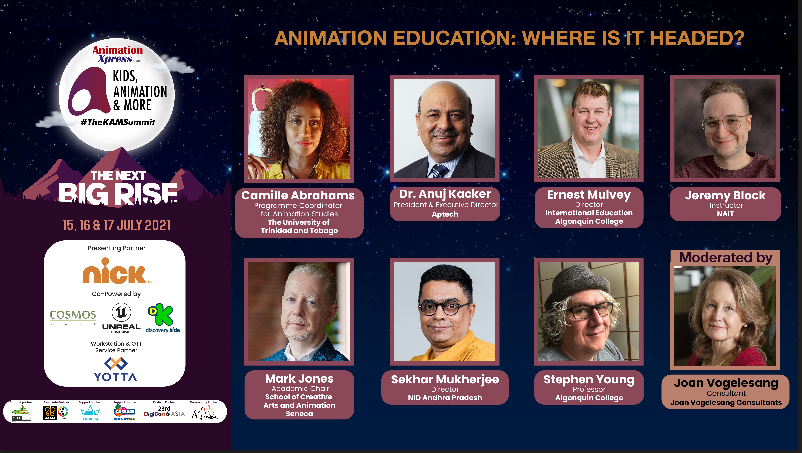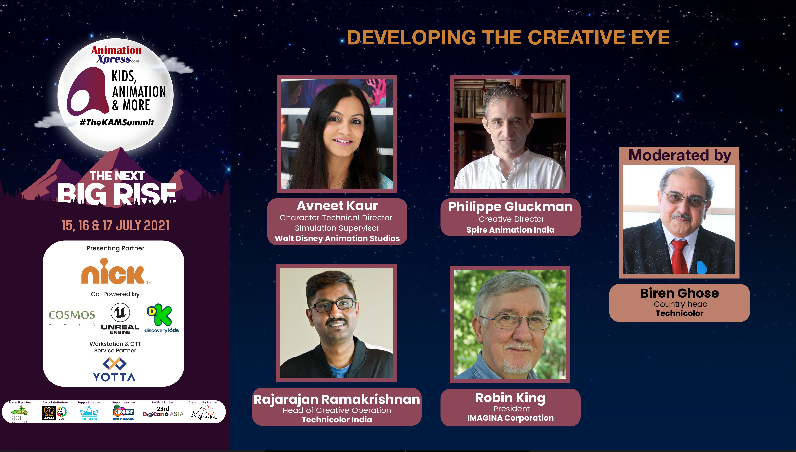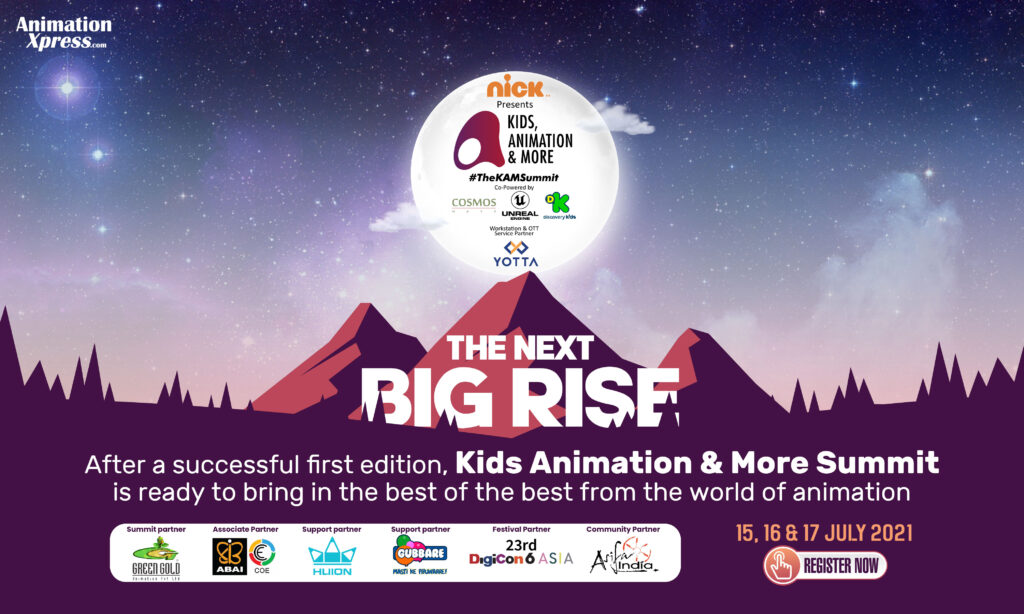
Day one of the KAM Summit received a great response and participation from both the Indian and International industry. KAM Summit is presented by Nick and is co-powered by Cosmos-Maya, Unreal-Engine and Discovery Kids. YOTTA serves as the workstation and OTT service partner whereas Green Gold Animation is the summit partner. ABAI promoting Centre of Excellence – COE are the associate partners and the event is supported by IN10 Media (GUBBARE) and HUION. Digicon6 Asia is the festival partner and ASIFA India serves as the community partner.
The first session of day two KAM Summit had Yotta Infrastructure DGM – product and services Sandeep Pathak speak about ‘OTT platform as a service.’
“Yotta started with a mission to propel digital transformation in India. We are building all our services with a vision. We want to break the myth that you have to spend a huge amount of money in India to get services like CAPEX and OPEX. If we compare some of our plans with the global players, we are giving bigger advantages to the customers, especially when it comes to work from anywhere and flexibility,” said Pathak.
He further said, “With the help of technology, one will be able to come up with your own OTT platform in days and without any issues. You will have the added benefit of delivering content on your own platform. Yotta provides a content delivery network with the capability to stream to worldwide audiences with no interruption. What used to take 24 days to launch was just finished in 24 hours. You will be able to launch your seamless platform and grow your base in no time.”
While commenting on the topic of discussion, Pathak concluded, “Since we are partnered with major CDM players, scalability will not be an issue.”
The next session, “Brands, Innovation and kids” saw experts talks about how they are innovating when advertising on kids channels and OTT platforms. The panelist included Savlon India, ITC Limited marketing manager Ankur Bhatia, Parle sr. category head Krishnarao Buddha, Madison Media Sigma CEO Vanita Keswani, Viacom18 head of marketing – kids TV network, Sonali Bhattacharya and the session was moderated by Havas Media Group India CEO Mohit Joshi.
Keswani shared that the fast-food industry is incorporating movie and television characters with which children already have an emotional bond so that the children could feel the characters in real life.
Bhattacharya mentioned that it is necessary to keep the kids engaged and entertained keeping in mind their safety. “Because of the pandemic and the given situation, kids are adulting very quickly. They even have a point-of-view on the India-China war.”
More than 60-70 per cent of kids in India do prefer the internet over television. TV still rules the roost when it comes to our country, however, according to Bhatia, marketers need to treat the digital medium with respect.
“Although we have a significant and increased digital presence every year, still it becomes very challenging when it comes to kids,” Buddha added.
Next up was the session “New Kids on the Block” with the panellists Hungama senior vice president Soumini Sridhara Paul, Toonz Media Group SVP and head digital division Abraham Uthup, IN10 Media Network network VP – corporate strategy and development Mansi Darbar. It was moderated by Animation Xpress founder, chairman & editor-in-chief Anil Wanvari.
It’s been raining OTT platforms in India for the past few years which has given a big leap to more fresh and new content as well as acquired content too. Similarly, following the OTT giants, new OTT and linear TV channels are developing. It’s tough for the new entrants to set footprints where OTT giants have already set their benchmark. Digital platforms and kids content; two things that have gained a lot of traction in the past two years. The experts tapped various aspects including challenges that new entrants are facing currently like digital distribution, reach, subscription plans and competitiveness and how with quality content they can set their footprints among all other giants.
It was followed by a masterclass by Gaumont pipeline architect- supervising technical director Esan Mandal where he shared insights on the animation pipeline. He shared, “The goal of an animation pipeline is to create animation content efficiency. Production can be split into three parts; pre-production, production and post-production.”
He took a holistic view of the Animation Pipeline and shared his viewpoints for a better understanding of its core ideas. He tapped the fundamental philosophies resulting in a flexible pipeline that addresses current needs and accommodates future growth.
“In animation, you are producing tons of data; maybe in the range of hundreds of terabytes. A pipeline lets you manage that data and scale. It implements the production process and policies so that you don’t have to rely on people’s memories,” he added.
The next session was “The Storytelling Canvas: Text to Frames” which focused on giving a detailed view on the art of storytelling and the process of developing ideas to construct storyboards.
The masterclass was taken by Green Gold Animation creative manager Apoorva Idaya and head of 2D pre-production Tirtho Ghosh.
Idya explained the different steps involved in animation story development including ideation, synopsis and scripting.
She gave a detailed presentation on how to write different formats of the script, by playing a small clip from Mighty Little Bheem, and then took through the process of how to write a beat sheet structure for non-dialogue shows.
Ghosh discussed the importance of storyboarding and different stages in storyboarding including script breakdown, making of thumbnails, staging and clean up.
Idya and Ghosh shared their thoughts about how the writing, creative and production team has to work together. They also highlighted how every show and channel have a certain set of do’s and don’ts for the content and codes to be followed while producing for different age groups.
In the next session, Dubit global trends SVP David Kleeman and Dubit media insights SVP Adam Woodgate shared interesting insights on the “Global trends in the kid’s ecosystem“.
They mentioned how the explosion in digital equipment has allowed for an increasingly diverse offer, creating new uses and thus helping to push up viewing times across the world. No sector has been more deeply affected by these changes than kids’ TV. While children today, more than ever, can’t get enough of the small screen, the way they watch content is changing fast.
When the COVID-19 pandemic spread and governments worldwide enforced school closure as part of their containment strategy, digital technology and virtual learning played a vital role in ensuring some degree of class continuity. “In India, 93 per cent of the kids have access to TV sets, 24 per cent to tablets, 29 per cent to smartphones, 23 per cent to gaming consoles, and 28 per cent to PCs/laptops. 33 per cent of children’s waking time per week in India is spent in using screens, whereas 67 per cent of children’s waking time per week in the United States is spent in using screens,” asserted Adam Woodgate.
He concluded the informative session with a power-packed statement, “Child development doesn’t change; the context in which the child develops does.”
“Indian Kids Perspective” panel was an amazing, fun loaded session with energetic and amazing kids including Rudraaksh Mehta, Sara Rohit, Umana Chaudhuri, Atharv Singh Rathore and Kashvi Handia and the session was moderated by parentune founder and CEO Nitin Pandey.
In this panel, kids shared their thoughts about what animation is, their favourite characters and what they like about them.
It was pretty exciting to hear from the kids about Optimus, Bumblee, Luca, Frozen, Little Pony, Little Singham in their way of storytelling.
This session provided the kids’ perspective and consumption patterns on animation content.
The round of adorable kids sessions continues with kids’ perspectives from around the world. The speakers of this session were Taanish Makwana and Risha Mandal from US, Danilo Aly Voss Nyan from Norway, Sihyeong (Mars) Lee from Korea, Vivika Puranik and Krishna Chaudhuri from India and the session was moderated by parentune founder and CEO Nitin Pandey.
The kids shared who were their favourite characters and why they are their favourites. The kids further talked about the games they like to play and ho if given a chance, what kind of movie would they like to make.
Apart from that the kids also shared how closely they could relate to the character of their choice sometimes because of their character similarities and sometimes due to character’s qualities that got them gravitated towards them.
Fireside chat with Jamaica prime-minister office animation specialist Robert Reid witnessed an informative presentation where Reid provided us with valuable information about the emerging Jamaican animation Industry.
He highlighted the Caribbean island as an emerging market for the distribution of homegrown-local animation content as well as international films and animation.
He also shared about the YEDAI project funded by the World Bank which focuses on supporting youth employment in the digital and Animation Industries. It is an investment of 20 million US dollars to support the program.
Reid also shed light on the animation opportunities existing in Jamaica and their developments in the field of animation.
Moving on, the next session “Animation Education: Where is it headed” gave wider insights to the Animation Education ecosystem. While the lockdown forced physical classes to become virtual, how did it impact the world of animation? Animation skillsets are traditionally better taught in classrooms – students observe, collaborate, and assimilate while under supervision – alone and in teams. The session speakers were NID Andhra Pradesh director Sekhar Mukherjee, Aptech president & executive director Dr. Anuj Kacker, School of Creative Arts and Animation, Seneca Academic chair Mark Jones, The University of Trinidad and Tobago programme coordinator for animation studies Camille Abrahams, Algonquin College professor Stephen Young, Algonquin College director – international education Ernest Mulvey, NAIT Instructor Jeremy Block and it was moderated by Joan Vogelesang Consultants consultant Joan Vogelesang.
The session highlighted various challenges faced due to the pandemic including shifting classes completely online with limited/no technology support or devices which was one of the biggest challenges. However, considering the current pandemic scenario, many institutions are stepping forward to transform the technology landscape of the institution.
Joan Vogelesang pointed out, “We look at animation and production as the area of growth in India as well as in Caribbean. As an area of growth, young people like to get trained in because it gives them an opportunity where they are interested in game development or movies or whatever.”
Therefore it is very necessary for institutions as well as educators to provide that support to the students from every possible aspect including motivation, study resources, placements and so on.
“Developing the Creative Eye” session had a detailed discussion on how to develop a creative eye and how to nurture creativity throughout the different stages in our career and how to explore new techniques and use them in our own way.
The panel included industry personalities like IMAGINA Corporation president Robin King, Walt Disney Animation Studios character technical director-simulation supervisor Avneet Kaur, Spire Animation India creative director Philippe Gluckman and Technicolor India head of creative operation Rajarajan Ramakrishnan.
Moderated by Technicolor country head Biren Ghose, the session began with all the panelists giving their own definition of what is creative eye.
King shared about four discrete stages of creativity and how to understand the dynamics of creativity.
Ramakrishnan shared valuable moral points which not only develop the creative but also helps in creating a successful career and maintaining a balance in work life.
Kaur said that for an artist the most important element for growth is being receptive to the feedback because sometimes we are not able to figure out things that others have figured out.
Ghose delivered a powerful quote saying that the average creatives discuss, debate and spot the wrong answers but brilliant creatives spot the wrong questions.
Gluckman shared a very interesting point about how a studio has to give the audience a chance to explore and experience failure and success and how we all have to work together for global happiness.
The panel members discussed how technology has evolved and how tools play a significant role in the field of artistry and how the inner passion and fire drives one to open the creative eye.
Here are the Day 2 sessions :

